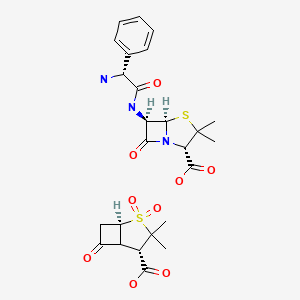CASRN: 94935-63-4

Drug Levels and Effects
Summary of Use during Lactation
Ampicillin-sulbactam produces low levels in milk that are not expected to cause adverse effects in breastfed infants. Occasionally, disruption of the infant's gastrointestinal flora, resulting in diarrhea or thrush, have been reported with penicillins, but these effects have not been adequately evaluated. Ampicillin-sulbactam is acceptable in nursing mothers.
Drug Levels
Maternal Levels. In 3 mothers who received intramuscular ampicillin 2 grams daily, milk levels ranged from 0.3 to 0.9 mg/L. In 3 mothers who received 4 grams daily intramuscularly, milk levels ranged from 0.4 to 0.9 mg/L. In all cases, peak milk levels occurred 3 hours after the dose. The breastfed infant was estimated to receive from 0.08 to 0.2 mg daily of ampicillin with these doses.[1]
In 15 women receiving ampicillin 500 mg 4 times daily by intramuscular injection, average milk ampicillin levels were as follows: 0.11 mg/L at 30 minutes after the injection; 0.21 mg/L at 1 hour, 0.17 at 2 hours, 0.27 mg/L at 4 hours and 0.26 mg/L at 6 hours after the injection.[2]
In 15 women given a single 2 gram dose of ampicillin intravenously, milk levels averaged 1.1 mg/L at 2 hours after the dose.[3]
A study in postpartum women with endometritis who received ampicillin 1 gram plus sulbactam 0.5 gram or ampicillin 2 grams plus 1 gram of sulbactam infused intravenously over 20 minutes found the average milk levels of ampicillin to be 1.7 mg/L with the highest level observed 3 mg/L. Sulbactam milk levels averaged 0.58 mg/L with the highest level observed 2.8 mg/L.[4]
Milk was collected at random times after 0.5 or 1 gram doses of sulbactam infused intravenously over 20 minutes. Little fluctuation occurred in milk levels over the first 8 hours after the dose with little difference in milk levels between the two dosages. Milk levels averaged 0.52 mg/L during this period with the highest level being 2.8 mg/L. Other levels from 10.5 to 20.5 hours after the dose ranged from 0.12 to 1.2 mg/L.[5] It is unclear whether some of the patients in this report were the same as those in reference[4].
Infant Levels. Relevant published information was not found as of the revision date.
Effects in Breastfed Infants
Relevant published information on ampicillin and sulbactam was not found as of the revision date; however, there are data on ampicillin alone. In a prospective follow-up study, 5 nursing mothers reported taking oral ampicillin (dosage unspecified). One mother reported diarrhea in her infant. No rashes or candidiasis were reported among the exposed infants.[6]
A small, controlled, prospective study had mothers taking ampicillin monitor their infants for signs of adverse effects (furring of the tongue, feeding difficulties, changes in stool frequency and consistency, diaper rash, and skin rash). Weight change and the development of jaundice were also recorded. No statistical differences in these parameters were found between the infants of the control mothers and those of mothers taking oral ampicillin.[7]
Effects on Lactation and Breastmilk
Relevant published information was not found as of the revision date.
References
- 1.
- 2.
- Amiraslanova LA, Emel'yanova AI, Fursova SA, et al. Some aspects of ampicillin, kanamycin and cefuroxim pharmacokinetics in puerperant patients with endometritis. Akush Ginekol (Mosk) 1985;10 14-7 [PubMed: 2934996]
- 3.
- Zhang Y, Zhang Q, Xu Z. Tissue and body fluid distribution of antibacterial agents in pregnant and lactating women. Zhonghua Fu Chan Ke Za Zhi 1997;32:288-92 [PubMed: 9596854]
- 4.
- Foulds G, Miller RD, Stankewich JP, et al. The pharmacokinetics of subactam and ampicillin in postpartum women. In, Spitzy KH, Karrer K, eds. Proc 13th Int Congress Chemother 1983;1:23/17-23/2.
- 5.
- Foulds G, Miller D, Knirsch AK, et al. Sulbactam kinetics and excretion into breast milk in postpartum women. Clin Pharmacol Ther 1985;38:692-6 [PubMed: 2998677]
- 6.
- Ito S, Blajchman A, Stephenson M, et al. Prospective follow-up of adverse reactions in breast-fed infants exposed to maternal medication. Am J Obstet Gynecol 1993;168:1393-9 [PubMed: 8498418]
- 7.
- Campbell AC, McElnay JC, Passmore CM. The excretion of ampicillin in breast milk and its effect on the suckling infant. Br J Clin Pharmacol 1991;31:230p.doi:10.1111/j.1365-2125.1991.tb05523.x [CrossRef]
Substance Identification
Substance Name
Ampicillin and Sulbactam
CAS Registry Number
94935-63-4
Drug Class
Breast Feeding
Lactation
Milk, Human
Anti-Infective Agents
Anti-Bacterial Agents
Penicillins
beta-Lactamase Inhibitors
Disclaimer: Information presented in this database is not meant as a substitute for professional judgment. You should consult your healthcare provider for breastfeeding advice related to your particular situation. The U.S. government does not warrant or assume any liability or responsibility for the accuracy or completeness of the information on this Site.
Publication Details
Publication History
Last Revision: June 15, 2024.
Copyright
Attribution Statement: LactMed is a registered trademark of the U.S. Department of Health and Human Services.
Publisher
National Institute of Child Health and Human Development, Bethesda (MD)
NLM Citation
Drugs and Lactation Database (LactMed®) [Internet]. Bethesda (MD): National Institute of Child Health and Human Development; 2006-. Ampicillin and Sulbactam. [Updated 2024 Jun 15].